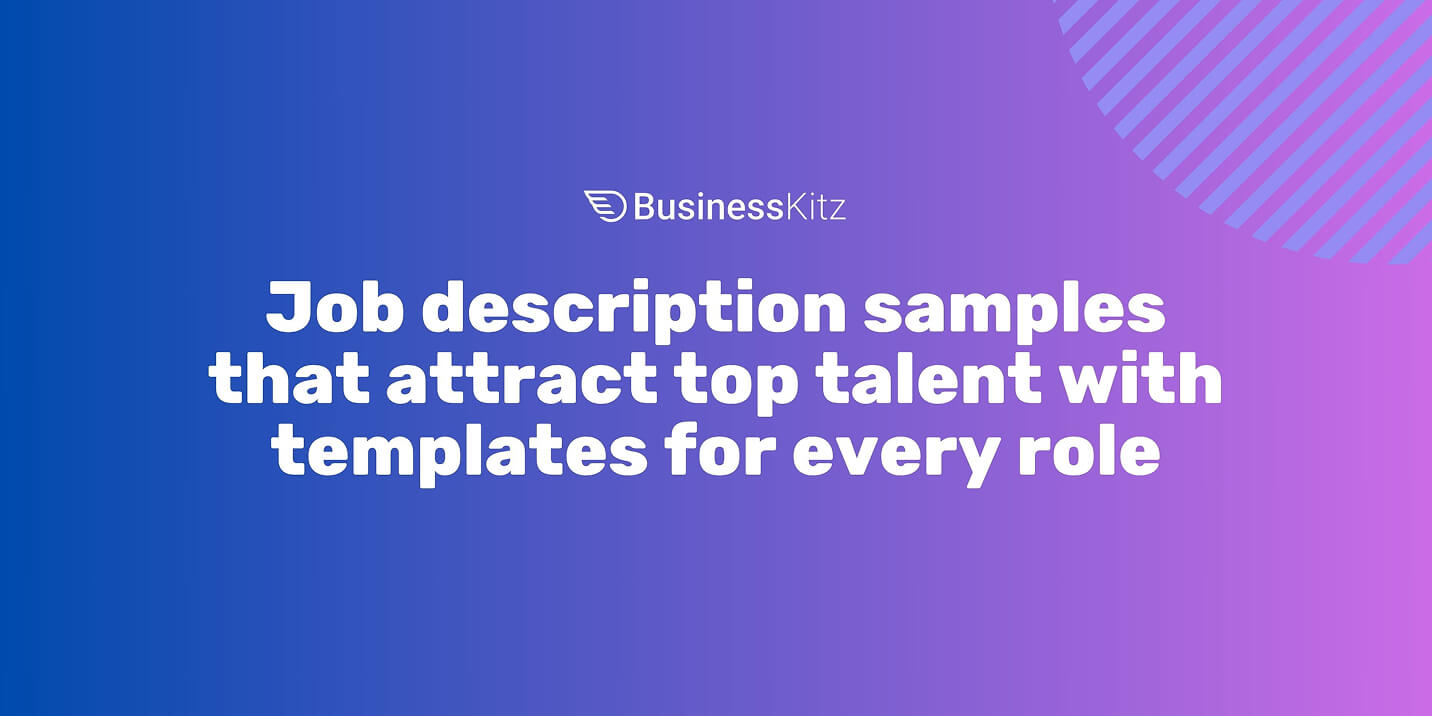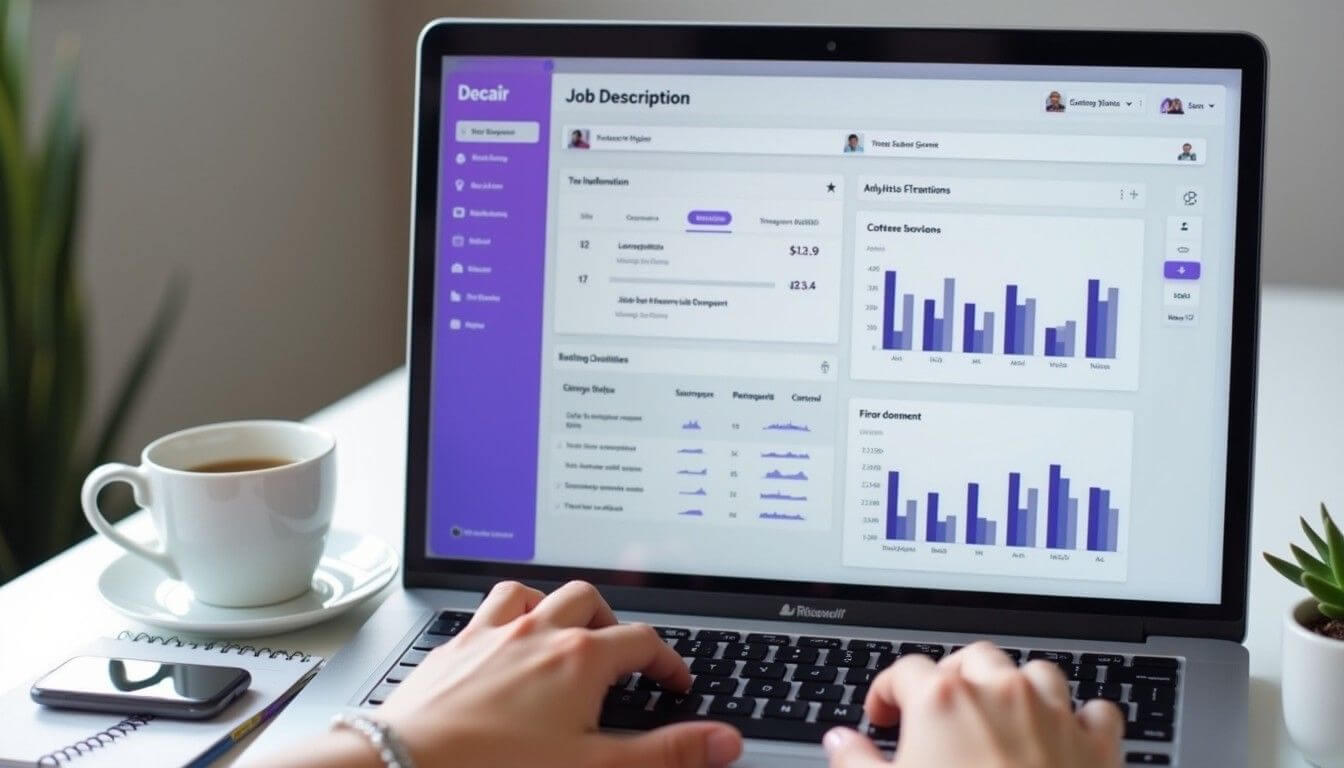
Looking for job description samples that work? You're not alone—with 52% of job seekers saying the quality of a job description significantly influences their decision to apply, getting this document right can make or break your recruitment efforts. Whether you're a startup founder writing your first job description or an HR professional updating existing ones, having access to quality samples and understanding best practices is crucial for attracting the right candidates. The good news? Creating compelling job descriptions doesn't require starting from scratch every time. Let's explore how to use job description samples effectively, avoid common pitfalls, and build a library of templates that grow with your business.
We've helped businesses save $55m with our all-in-one platform. Get instant access to this template and 115+ others, plus AI-powered document creation, starting completely free.
Before diving into specific samples, it's essential to understand what separates mediocre job descriptions from ones that attract quality candidates. An effective job description sample serves as more than just a list of duties—it's a strategic recruitment tool that communicates your company's value proposition while clearly outlining role expectations.
The best job description samples include these critical components:
Clear job title and summary: Skip trendy titles like "Marketing Ninja" or "Sales Rockstar." Standard titles help candidates find your posting and immediately understand the role they are applying for. Your summary should provide a compelling overview in 3-4 sentences that capture the role's purpose and impact.
Specific responsibilities and duties: List 5-7 key responsibilities in order of importance. Use action verbs and be specific about outcomes. Instead of "manage social media," write "create and publish 20 social media posts monthly across Facebook, Instagram, and LinkedIn to increase brand engagement by 15%."
Required vs preferred qualifications: 47% of candidates don't apply because they lack specific years of experience listed. Distinguish between must-have skills and nice-to-have qualifications to avoid deterring qualified candidates unnecessarily.
Company culture and benefits: With 72% of job seekers wanting culture details, include information about your work environment, team dynamics, and growth opportunities. This helps candidates self-select for cultural fit.
Salary range and working conditions: Quality candidates look for transparency. Include salary bands, working hours, location requirements, and any unique aspects of the role like travel or weekend work.
At Business Kitz, we've analysed hundreds of successful job descriptions to create templates that balance comprehensiveness with readability, ensuring you attract candidates who are both qualified and genuinely interested in your opportunity.
Creating a job description from a sample requires understanding the purpose of each element and how they work together to attract suitable candidates. Let's break down the essential elements that transform a basic job listing into a powerful recruitment tool.
Start with the fundamentals that help candidates quickly assess relevance:
Your overview should answer "Why does this role exist?" in 3-4 sentences. Focus on the role's impact within your organisation and how it contributes to broader company goals. This section sets expectations and helps candidates envision their potential contribution.
Structure this section for maximum clarity:
For example: "Develop and implement monthly content calendars for three brand social media accounts, ensuring consistent posting schedule and 20% quarterly engagement growth."
Divide qualifications strategically:
Essential requirements (must-haves):
Preferred qualifications (nice-to-haves):
Be transparent about:
This transparency prevents mismatched expectations and helps ensure long-term employee satisfaction.

Even with quality samples, it's easy to fall into traps that undermine your recruitment efforts. Understanding these pitfalls helps you adapt samples effectively rather than copying them blindly.
Plagiarising job descriptions from other companies damages your employer's brand and may not accurately reflect your specific needs. Each organisation has a unique culture, processes, and requirements that generic descriptions can't capture.
Instead of copying wholesale:
Long lists of requirements deter qualified candidates. When every skill seems essential, candidates may self-disqualify despite being capable of excelling in the role.
Keep requirements realistic by:
With 43% of companies failing to update their job descriptions, many recruiters rely on outdated information. Roles evolve, technologies change, and market expectations shift—your descriptions should reflect current reality.
Schedule regular reviews to:
Certain words and phrases can unconsciously discourage diverse candidates. Terms like "aggressive," "rockstar," or "ninja" may alienate qualified candidates who don't identify with these descriptors.
Write inclusively by:
Business Kitz's document management platform helps you maintain a centralised library of job descriptions, making it simple to track versions, schedule reviews, and ensure consistency across your organisation.

Different departments require unique approaches to job descriptions. Here's how to adapt your samples for various roles while maintaining consistency in format and quality.
Administrative positions form the backbone of your organisation. Sample structure for an Office Manager:
Position Summary: Oversee daily office operations for a 50-person team, ensuring smooth administrative processes and creating an efficient, welcoming work environment that supports productivity and collaboration.
Key Responsibilities:
These roles require clear performance expectations. Sample for a Digital Marketing Specialist:
Position Summary: Drive online brand visibility and lead generation through strategic digital marketing campaigns across multiple channels, contributing to 30% annual revenue growth targets.
Key Responsibilities:
Technical positions need precise skill requirements. Sample for a Full Stack Developer:
Position Summary: Build and maintain scalable web applications that serve 100,000+ users, working collaboratively with cross-functional teams to deliver innovative solutions that drive business growth.
Key Responsibilities:
Service roles emphasise soft skills alongside technical abilities. Sample for a Customer Success Manager:
Position Summary: Partner with enterprise clients to maximise product value, ensuring 95%+ retention rates through proactive support, strategic guidance, and relationship building.
Key Responsibilities:
Generic samples provide structure, but personalisation transforms them into powerful recruitment tools. Here's how to adapt samples while maintaining your unique employer brand.
Your job descriptions should reflect what makes your organisation distinctive. Consider these customisation strategies:
Start with your company voice. If your brand is innovative and dynamic, use energetic language to convey its personality. For traditional industries, maintain professional formality. The key is consistency with other company communications.
Highlight unique benefits beyond standard offerings:
Different sectors have varying expectations and terminology. Adapt your samples by:
For startups: Emphasise growth opportunities, equity potential, and the chance to wear multiple hats. Be honest about the fast-paced environment and evolving responsibilities.
For corporations: Focus on structured career paths, comprehensive benefits, and stability. Include information about team size and reporting structures.
For non-profits: Highlight mission alignment, community impact, and the meaningful nature of the work. Be transparent about funding constraints while emphasising non-monetary rewards.
The most effective job descriptions accurately reflect day-to-day reality. Interview current employees to understand:
This ground-level insight ensures your descriptions attract candidates who'll thrive in the actual role, not an idealised version.
Depending on your location and industry, certain elements may be legally required:
Work with your legal team to ensure samples meet all requirements while remaining engaging and readable.
Building a comprehensive template library streamlines recruitment while ensuring consistency across your organisation. Here's how to develop and maintain templates that evolve with your business.
Structure your library for easy access and updates:
By department: Create folders for each department with role-specific templates. This helps hiring managers quickly find relevant samples.
By level: Separate templates for entry-level, mid-level, senior, and executive positions. Each level requires a different emphasis on experience versus potential.
By employment type: Maintain distinct templates for full-time, part-time, contract, and internship positions, using appropriate terminology and expectations.
Business Kitz's document library feature provides the perfect solution for organising your job description templates, with easy search functionality and version control to track changes over time.
Create a consistent framework that maintains professionalism while permitting customisation:
Standard elements (keep consistent):
Flexible components (customise per role):
Job descriptions evolve—your system should track these changes:
Digital document management eliminates confusion about which version is current and provides an audit trail for compliance purposes.
The best templates emerge from collaboration:
Involve key stakeholders:
Gather feedback systematically:
This collaborative approach ensures templates remain relevant and effective across your organisation.

Modern businesses need more than Word documents to manage job descriptions effectively. The right tools transform static documents into dynamic recruitment assets.
Moving beyond traditional document management offers significant advantages:
Centralised access: Store all job descriptions in one searchable location, eliminating duplicate versions and ensuring everyone uses current templates.
Real-time collaboration: Multiple stakeholders can review and suggest changes simultaneously, speeding up the approval process while maintaining document integrity.
Automated workflows: Set up review schedules, and approval chains, and update reminders to keep descriptions current without manual tracking.
Business Kitz's document signing feature streamlines the approval process, enabling HR managers and department heads to digitally sign off on job descriptions, thereby creating an audit trail for compliance.
Your job description management should seamlessly connect with broader recruitment workflows:
Maintaining proper documentation protects your organisation:
Track changes: Document who updated descriptions and when providing clarity for legal requirements and internal reviews.
Approval histories: Maintain records of sign-offs from relevant stakeholders, demonstrating due diligence in job description development.
Archive past versions: Keep historical descriptions for reference in performance reviews or legal matters while clearly marking current versions.
Data-driven refinement improves recruitment outcomes:
These insights help you continuously improve templates based on actual results rather than assumptions.
Creating excellent job descriptions is just the beginning—maintaining their relevance and accuracy ensures continued recruitment success.
Establish systematic review processes:
Annual reviews: Conduct comprehensive reviews of all job descriptions yearly, aligning with performance review cycles or budget planning.
Trigger-based updates: Update immediately when:
Quarterly spot checks: Review high-turnover positions or rapidly evolving roles more frequently to ensure accuracy.
Successful maintenance requires input from multiple perspectives:
Current employees: They understand daily realities and can identify outdated elements or missing responsibilities.
Managers: Provide insight into evolving team needs and future skill requirements.
HR professionals: Ensure consistency, compliance, and alignment with organisational policies.
Recent hires: Offer fresh perspectives on whether descriptions accurately reflected their roles.
Link job descriptions to performance management:
This connection ensures job descriptions remain living documents that support employee success.
Stay competitive by monitoring external factors:
Business Kitz's profiles feature helps you maintain comprehensive employee records, making it easy to track role evolution and ensure job descriptions reflect actual responsibilities.
Most effective job descriptions typically range from 700 to 1,000 words. This provides enough detail to attract qualified candidates while remaining scannable. Include a brief summary (3-4 sentences) for job boards, with full descriptions on your careers page. Focus on quality over quantity—every sentence should add value for potential applicants.
Review job descriptions at least once a year, with quarterly checks for rapidly evolving roles. Update immediately when roles change significantly, new technologies are adopted, or compliance requirements shift. With 43% of companies never updating descriptions, regular reviews give you a competitive advantage in attracting talent.
Yes, whenever possible. Salary transparency attracts more qualified candidates and saves time by allowing self-selection based on compensation expectations. If you can't provide exact figures, include salary bands or ranges. Some jurisdictions now require salary disclosure by law.
A job description is an internal document detailing all aspects of a role, including specific procedures and evaluation criteria. A job posting is an external-facing advertisement derived from the job description, optimised to attract candidates with compelling language and focused on key selling points.
Use neutral language, avoiding gender-coded terms. Focus on essential skills rather than arbitrary years of experience. Include your commitment to diversity and inclusion. Offer multiple ways to meet requirements (e.g., "Bachelor's degree or equivalent experience"). Have diverse team members review descriptions for unconscious bias.
AI tools can help generate initial drafts and suggest improvements, but human review remains essential. AI can identify biased language, suggest skill requirements, and ensure consistency across all aspects of the process. However, only humans can accurately capture company culture, team dynamics, and role nuances that attract the right candidates.
Begin by identifying the business need that drives the creation of the role. Interview stakeholders to determine their expected outcomes and responsibilities. Research similar positions at comparable companies. Create a draft and test it with potential candidates for feedback. Be prepared to adjust based on the calibre of applicants attracted.
Well-crafted job descriptions do more than fill positions—they attract talent aligned with your vision and set clear expectations for success. By using high-quality samples as starting points, avoiding common pitfalls, and maintaining systematic descriptions, you create a competitive advantage in talent acquisition. Remember, the best job descriptions evolve with your organisation, reflecting current realities while inspiring candidates about future possibilities. Ready to build a professional job description library that grows with your business?
Sign up for free and gain access to Business Kitz's comprehensive job description templates and document management tools to streamline your recruitment process today.
Copyright © 2025 Business Kitz 14312161